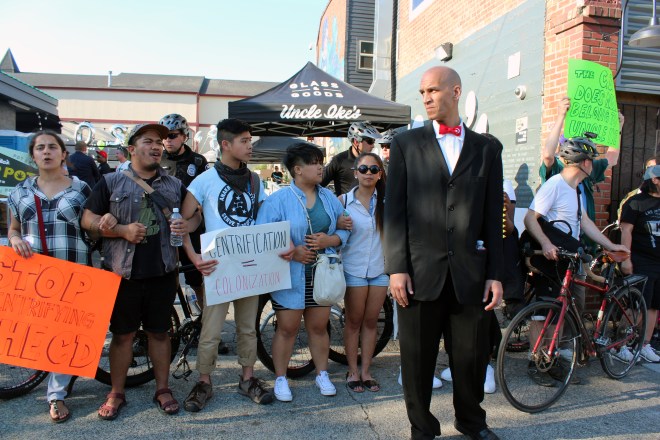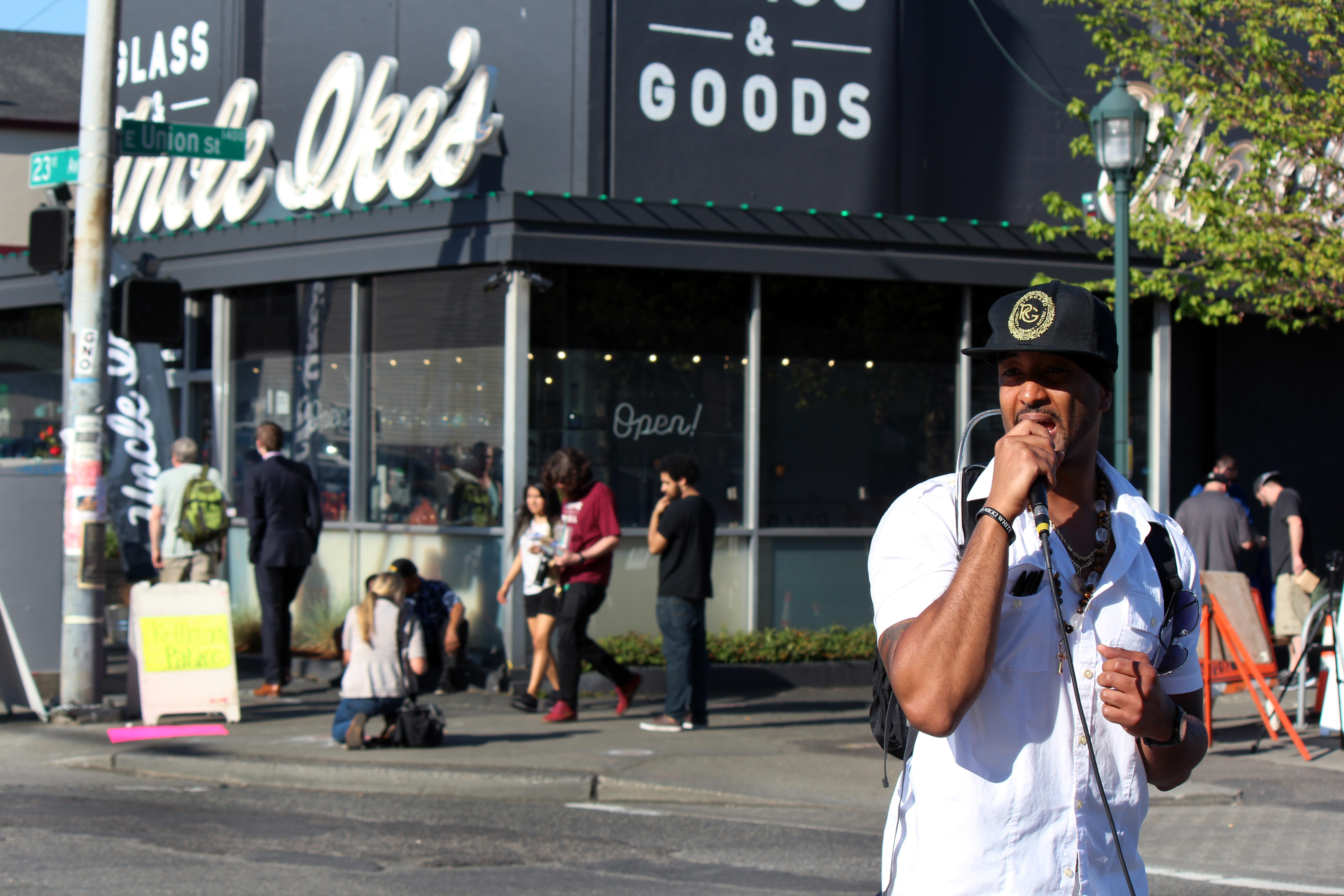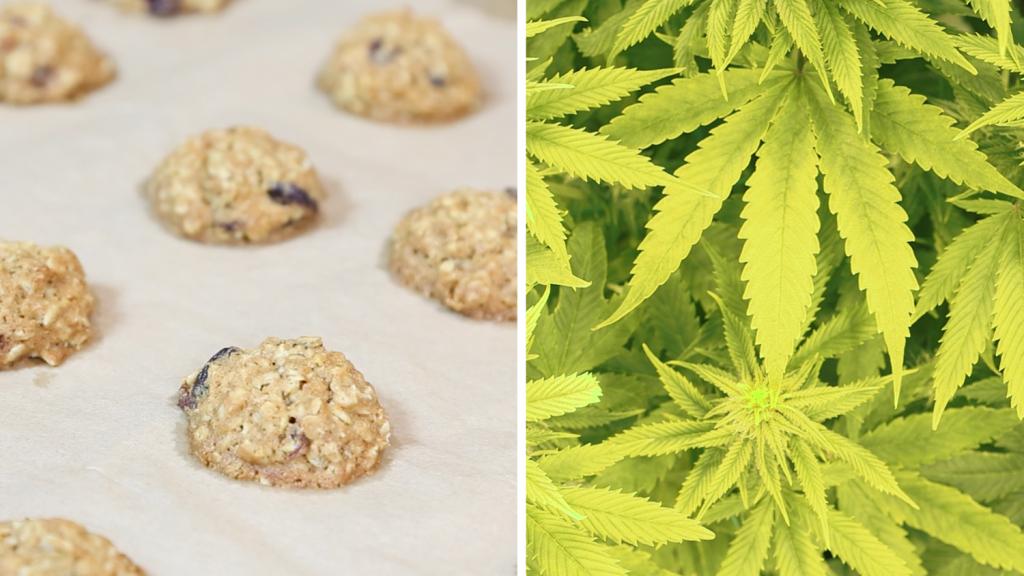It’s a cool, It�
The mostly young, mostly white patrons climb out of their cars, show their IDs to the bouncer, and slip into the glossy boutique. Inside, customers stock up on marijuana in almost every form imaginable: buds, joints, tinctures, elixirs, candies, breath mints, lip balm, and chocolates. There’s cannabis-infused body scrub, mango-flavored caramel chews, and gluten-free parmesan crisps. In the parking lot, next to a patio with mini cafe tables, an organic food truck serves vegan “fish” tacos and lentil-kale burgers.
Uncle Ike’s is one of Seattle’s most popular recreational marijuana shops. It’s got good prices, flashy decor, and, on occasion, a dapper, old-school van that shuttles customers to and from the hipster bars. But Uncle Ike’s is also at the center of controversy.
On Martin Luther King, Jr. Day this year, a group of activists broke off from the city’s annual march to raise fists and flags at Uncle Ike’s. Calling themselves the Seattle Black Book Club, the activists were targeting owner Ian Eisenberg. “We have assembled at Uncle Ike’s today to stand up and speak out against gentrification and the harm it causes our communities,” said the activists in a statement, calling Eisenberg, who is white, “a developer” and demanding that he return his profits to the community. Just a few days ago, on April 20, another angry protest targeted Uncle Ike’s. Protestors from the local NAACP and several other activist groups blocked the intersection for hours, shouting “Hey hey, ho ho, Uncle Ike’s has got to go” and hoisting signs with messages like, “Liberation, Not Gentrification” and “The C.D. doesn’t belong to Uncle Ike.”
Marijuana legalization didn’t cause the recent wave of gentrification in Seattle. By most accounts, the tech industry did that. Nevertheless, there’s no question that the Central District is changing, dramatically, and the legal weed business is the latest symbol of the rapidly gentrifying neighborhood. Fancy condo complexes and artisanal shops are in, people without wealth — and often, people of color — are being priced out. As Grist documented last year, Seattle is scrambling to meet a sharp uptick in housing demands. According to the U.S. Census Bureau, from 2014 to 2015 the Seattle metro area saw a population increase of 60,000 residents. Rents have skyrocketed.
As the city’s population grows, so does the retail marijuana industry, which opened for business in both Washington and Colorado in 2014, and in Oregon in 2015 (Alaska isn’t far behind). Nationally, legal marijuana sales hit $3.4 billion last year, and Marijuana Business Daily estimates that the U.S. cannabis industry could be worth $44 billion annually by 2020. Some researchers call legal weed the fastest-growing industry in the U.S. So far, particularly in Seattle and Denver, two cities where the rise of the recreational weed business has coincided with the advent of gentrification, longtime residents are left wondering who stands to gain and who to lose.
“It makes me sad,” says Luzviminda “Lulu” Carpenter, a community activist and radio show host who wishes, like many long-term Central District residents, that there were more community hubs — especially those that “value black lives” — not just pot shops and mid-rise condos replacing some of the old neighborhood. “Gentrification … it’s heartbreaking.”

Protesters at 23rd Avenue and East Union Street in SeattleSara Bernard
Seattle’s 23rd and Union block may now resemble many other recently-gentrified urban neighborhoods, i.e. a playground for millennials with disposable income. But 23rd and Union wasn’t always pot caramels and lentil-kale sandos. Less than a decade ago, the block was one of the most dangerous corners in the city, splattered with homicide, drug deals gone wrong, police brutality, and protests. Here, former Seattle mayor Paul Schell got slammed in the face with a megaphone. Here, gunfire took the lives of two different owners of the same sandwich shop.
But the surrounding Central District was also once the beating heart of Seattle’s African-American community. For decades, the area brimmed with arts organizations, mom-and-pop restaurants, and small businesses. A church, the still-thriving Mount Calvary Christian Center, is mere feet from Uncle Ike’s. (Mount Calvary launched a lawsuit against the shop shortly after it opened, arguing that its proximity to the church’s teen center should be prohibited under state marijuana zoning laws; the church dropped the suit in 2015 when it ran out of money for legal fees.) In 1970, the Central District was 73 percent black. Today, that number is less than 20 percent.
Now, catty-corner to Uncle Ike’s stands “The Central,” a glossy, six-story, 92-unit apartment building. One-bedroom rents start at $1,600 a month. The project’s developer, Lake Union Partners, plans to construct a second building across the street, on top of what is now a community garden and a gas station, and yet a third a block away. A commercial strip on the southeast corner, home to a handful of African-American–owned businesses, is for sale. It’s likely just a matter of time until this property is scooped up and redeveloped, too.
Uncle Ike’s rakes in about $1.4 million a month, more than any other pot shop in the city. The basic irony isn’t lost on Eisenberg, either: on the very same corner where many black men were arrested for dealing or smoking pot, a white man is now legally bringing in seven-figure sales. (Nationwide, blacks are 3.7 times more likely to be arrested for marijuana possession than whites, according to an ACLU report from 2013). Eisenberg has been open to meaningful discussions on the topic, but he questions his own responsibility for gentrification. “Our system is kind of broken,” he says. “I agree the housing is ridiculous in this city and it’s getting worse.” But: “I’m a supply and demand guy. You build more, prices will come down.”
“I’ve always seen myself as a sort of anti-establishment person,” he adds. “I opened a weed shop, which is pretty anti-establishment. But now I’ve become The Man, or a symbol of The Man, and I’m still trying to understand that.”
Denver, like Seattle, has been gentrifying at breakneck speed, and has also experienced a legal pot bonanza. “This industry has created hundreds of millions of dollars flowing through our economy,” says Jason Thomas, principal of Avalon Realty Advisors, a Denver-based commercial real estate consulting group that specializes in the marijuana industry. The city’s “Green Rush” has driven up commercial real estate prices, in particular, as ganjapreneurs look for large, urban spaces to grow.
As a result, industrial buildings and warehouses that had languished for years “are now leasing for 2 to 3 times the market rate,” Thomas says, and selling for up to $300 a square foot. In recent history, that number was more like $50, says Paul Kluck, first vice president at real estate firm CBRE in Denver. After legalization: “Prices went bonkers,” Kluck says. “They’re still bonkers.”
The whole process is “putting a squeeze on the land in Denver,” Thomas adds, “that I think will have some negative consequences over time.”
Among them, perhaps: The impact on low-income residents. Warehouse space was once prime real estate for artists, cooperatives, food banks, and other small nonprofits, says Morgan Matter, a lifelong Denver resident who has been watching gentrification leap from neighborhood to neighborhood in recent years. “Those spaces are going away; people are being evicted and having a much harder time,” she says. “That is a new impact, I think, of weed.”
Certain stretches of Denver reek of dank bud; one pot-shop hotspot is known as “The Green Mile.” In RiNo (hipster for “River North”), a once-gritty arts district, “there are a huge amount of grow operations,” says Lauri Lynnxe Murphy, an artist, writer, and longtime Denver resident, “to the point where there’re parts you drive through and they just stink. You can smell the weed from a mile away.”
The arrival of grow houses and weed shops in historically lower-income parts of Denver is a concern for some community members. There’s one marijuana business for every 91 residents in three high-poverty, mostly Latino neighborhoods, according to data compiled by the Denver Post. Anecdotally, Matter says, the shops can feel like “the pioneering gentrifiers.” She mourns one bike cooperative that used to serve a lot of “homeless folks, kids of color, people who lived in the projects. Then their little warehouse space got turned into weed.”
Zoning laws restrict recreational marijuana operations to specific areas of the city. Denver, for example, requires that retail marijuana stores cannot be within 1,000 feet of schools, drug or alcohol treatment facilities, and child-care centers. Denver also requires that a pot shop cannot be within 1,000 feet of another pot shop, however the zoning laws can result in the clustering of operations in the districts that aren’t off-limits.
Still, even the people concerned about the issue are loath to peg the whole thing on marijuana. “Denver has been at the precipice” of gentrification mayhem for a number of reasons, says Murphy — the thriving economy, the population boom. “I think weed just pushed it over the edge.”
Seattle and Denver aren’t blind to the issues that prosperity brings — although, as Seattle Mayor Ed Murray told GeekWire, this explosive economic growth “is a great problem to have.” Both cities have made efforts toward expanding and preserving affordable housing. Seattle, in addition to creating the incredibly thorough planning document called the Housing Affordability and Livability Agenda, is considering an extra tax on homeowners that could help build more affordable homes and aid families at the brink of homelessness. Denver has its own agenda, the Inclusionary Housing Ordinance, although that plan stipulates that only 10 percent of newly-constructed housing units need to be deemed affordable.
Still, none of the millions in marijuana tax revenue in either city is currently earmarked for affordable housing. So far, most of Washington’s roughly $65 million in tax revenue last year is likely to go to youth drug use prevention and other public health programs. Colorado, which pulled in over $100 million in state tax revenue and nearly $1 billion in overall sales, made so much money in taxes that there was an initiative on the November 2015 ballot to decide what to do with the excess. Voters opted to build schools, launch youth programs and drug education initiatives, and to bolster law enforcement.
So far, few researchers have analyzed legal weed’s impact on urban development (though maybe someone should, as one academic told the New Republic, who explored this issue at length in Denver). However, studies on gentrification in the U.S., such as this one from Governing, find that gentrification is more pronounced in a few select cities. Atop Governing’s list of where gentrification is most dramatic: Portland, Ore., and Washington, D.C., two cities that have recently legalized. It’s fair to wonder: How will a legal weed industry affect property values in Portland and D.C., if at all? (Third on Governing’s list is Minneapolis, where marijuana advocates have called for legalization. And fourth? Seattle.)
If California votes to legalize this fall — which some predict could happen; it will be the state’s ninth try — how will a marijuana market influence a city like San Francisco, which, for all intents and purposes, gentrified long ago? In March, the median rent for a one-bedroom apartment in San Francisco was $3,590, the highest in the country.
In Seattle, the gentrification vs. marijuana tussle isn’t all gloom and doom. There are even specific changes happening at 23rd and Union that aim to hack away at the problem. A nonprofit housing developer just got $12.2 million in funding from the city to help build 115 units of affordable housing in what was once the area’s first African-American owned bank, a block down. And, hey, a good number of pot businesses donate to charity, too.
Not everyone who is frustrated by gentrification, by the way, is against legalization. “I don’t believe in people being criminalized for weed,” says Matter, the lifelong Denver resident. “I voted for it being legalized. I want it to stay legal. I want it to be legal everywhere.” Murphy, the artist and writer in Denver, concurs. But still: “I wish we had taken more time to think about the repercussions, and where our infrastructure was,” she says.
“I’m mad at the [Denver] City Council” for its relative inaction, Murphy adds, noting that it’s only a matter of time until she, too, could be forced to move out of her neighborhood — or out of Denver completely. “I’m mad at the city planners, and at the developers who are being irresponsible. I’m not mad at weed for this.”



